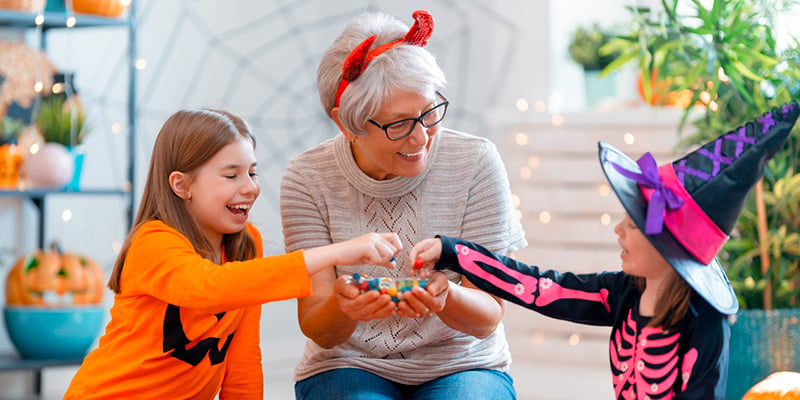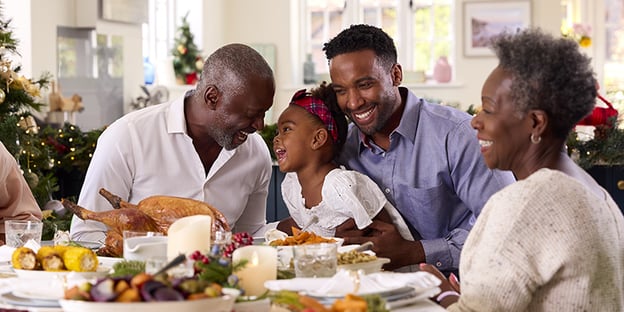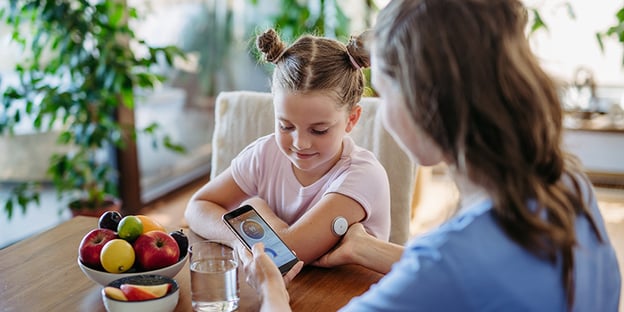When you think of Halloween, you think of candy. But for those with diabetes, the temptation for sweet treats can put their health in jeopardy, leading to hyperglycemia, diabetic ketoacidosis, and even kidney damage.
The good news? Whether you’re a parent looking for ways for your child to enjoy the holiday or an adult trying to pass up a plate of cookies at the office Halloween party, there are plenty of ways to have fun while managing your diabetes. Here are some of our favorite tricks for a healthier Halloween treat.
Trick 1: Treat Yourself, in Moderation
Living with diabetes doesn’t mean you can’t ever have sweets. As long as your doctor agrees, an occasional treat is usually fine. Just make sure to loop your care team in before you indulge, so they can modify your insulin doses as needed.
As a child, I gave myself seven “free days” a year where I could enjoy a sweet or two, under the guidance of my care team. I’d usually spend them on holiday parties, so I could feel like a normal kid who could have a cupcake for a friend’s birthday. If you choose to go a similar route, just make sure you tell your doctor before and after the free days, so they can make sense of the numbers they’re seeing on your continuous glucose monitor (CGM).
Trick 2: Make Educated Decisions
Not all Halloween treats are created equal. Halloween candy for Type I and Type II diabetes is out there. Just read the carb counts on the back of the packages, and budget the amount of carbs and sugar you can allow yourself, after consulting with your care team. A CGM can help you monitor your blood sugar levels to decide when and how much you can eat.
Here are some lower-carb Halloween treats to choose from:
- Goodbar: 1 fun-size bar, 4g
- Bit-O-Honey: 1 piece, 6g
- Dum-Dums: 1 pop, 6g
- Jolly Ranchers: 1 piece, 6g
- Charleston Chew: 1 piece, 9g
- Gobstoppers: 1 fun-size box, 8g
- NutRageous: 1 fun-size bar, 9g
- Milk Duds: 1 box, 9g
- Reese’s Sticks: 1 pack, 9g
- 3 Musketeers: 1 fun-size bar, 12g
- Almond Joy: 1 fun-size bar, 12g
- Mounds: 1 fun-size bar, 11g
- Kit Kat: 3 pieces, 10g
A word of warning: be careful of sugar-free candies. Some people with diabetes tend to overeat when given access to these lower-carb treats, but too many can have uncomfortable side effects like intestinal distress. Talk with your doctor before adding them to your diet.
Trick 3: Check Portion Sizes
The great thing about Halloween is that it’s easy to find fun-sized candies. The prepackaged smaller portion sizes make it harder to overeat, unless you’re willing to open a lot of packages to get your sugar fix. So, opt for smaller packets of candies, half of a cupcake, or a small portion of another treat, and fill up on healthier foods like fruits and vegetables so you have less room for candy.
Trick 4: Look for Alternatives
Limiting candy bars and lollipops doesn’t mean missing out on trick-or-treating. Thanks to the Teal Pumpkin Project, more and more households are providing non-edible treats like Halloween stickers, pencils, and small toys. Participating houses tend to place teal-colored pumpkins outside their door to signify their house is safe for children with food allergies and sensitivities. You can find the Teal Pumpkin houses near you or add yourself to the map on the Food Allergy Research and Education website. Even if you don’t see a teal pumpkin in your neighborhood, plenty of folks are now opting to provide non-food options or healthier treats like fruit.
After kids come home with their Halloween haul, try having them prioritize their treats. Instruct your child to sort through their bag of candy and select a certain number of favorite treats. They can enjoy those in moderation over the next couple of weeks and donate the rest. Try charities like:
- Treats for Troops – With a mission to make military members feel like kids in a candy store, this project of Texas-based nonprofit Soldiers’ Angels lets businesses volunteer as drop-off points for candy donations to send to deployed service members.
- Operation Shoebox – Based in Florida, this nonprofit prepares care packages for troops serving overseas. They accept prepackaged snacks and treats to bring a little cheer to military members.
- Halloween Candy Buyback – This Sacramento, California-based charity also supports the troops, but with a healthy spin. Started by dentists, it seeks to spread dazzling smiles by limiting sugary treats for kids and bringing some much-needed sweetness to soldiers.
- Ronald McDonald House Charities – Use your excess candy to put a smile on the face of a sick child when you donate it to this well-known charity that supports hospitalized children and their families.
For Halloween parties, it’s easy to ensure that healthy food will be available if you put yourself in charge of bringing it. Volunteer to supply a fruit platter, veggie tray, or other healthy dish. Dress up the offering by displaying it on skewers or get creative by adding almond slices to carrot sticks to create “witch fingers” or arranging crudité in the shape of a mummy or skeleton. Woman’s Day has some great inspiration for spooky, healthy creations.
Trick 5: Add in Some Exercise
Moderation doesn’t just mean limiting certain foods. It means balancing what you eat with what you do. So, plan to exercise after your treat. Go on a walk around your neighborhood, take a bike ride, or play a game of basketball. It can help counteract blood sugar spikes, promote overall health, and take your mind off tempting desserts.
Trick 6: Keep It Positive
Halloween is an important holiday for kids. They look forward to it all year long and plan their costumes for months in advance.
But if your child can’t participate in the festivities along with his classmates, they can feel alienated and different than the crowd when they and their peers want nothing more than to fit in.
So, try to keep the mood upbeat and positive. Involve your kids as much as possible in decisions about which treats to keep, which to donate, and where to donate them. Let them choose which candies they want to splurge on and how to modify their carb intake to allow for them.
You might even try making the tasks a game. How many pieces of candy can you stuff into a donation box in 30 seconds? Who can find the lowest-carb piece of candy in the Halloween bag? Who can come up with the best idea for spooky but healthy party treats? Involving your kids in these decisions can empower them and add to the fun of the holiday.
As you can see, diabetes doesn’t mean missing out on spooky Halloween fun. Armed with some education and your CGM, you can sample sweets while staying healthy. To learn more about which CGM is right for you, download our handy guide.







